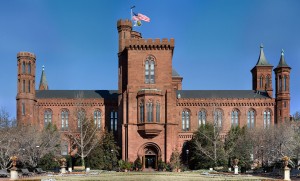Good morning, Whitewater.
Sunday in the city will be partly sunny with a high of eighty. Sunrise is 5:56 AM and sunset is 8:04 PM. It’s a full moon today, at 1:10 p.m. Central Daylight Time.
NASA tests a saucer-shaped vehicle using a high-altitude balloon:
On this day in 1946, Pres. Polk signs a bill creating the Smithsonian Institution:

The Smithsonian Institution …. smith-soe-nee-?n), established in 1846 “for the increase and diffusion of knowledge,” is a group of museums and research centers administered by the United States government. Originally organized as the “United States National Museum,” that name ceased to exist as an administrative entity in 1967.[1] Termed “the nation’s attic”[2] for its eclectic holdings of 137 million items,[3] the Institution’s Washington, D.C. nucleus of nineteen museums, nine research centers, and zoo—many of them historical or architectural landmarks—is the largest such complex in the world. Additional facilities are located in Arizona, Maryland, New York City, Virginia, Panama and elsewhere, and 168 other museums are Smithsonian affiliates. The Institution’s thirty million annual visitors[4]are admitted without charge; funding comes from the Institution’s own endowment, private and corporate contributions, membership dues, government support, and retail, concession and licensing revenues.[3] Institution publications include Smithsonian and Air & Space magazines….
British scientist James Smithson (d. 1829) left most of his wealth to his nephew Henry James Hungerford; however, when Hungerford died childless in 1835,[5] the estate passed “to the United States of America, to found at Washington, under the name of the Smithsonian Institution, an Establishment for the increase & diffusion of knowledge among men.”, in accordance with Smithson’s will.[6] Congress officially accepted the legacy bequeathed to the nation, and pledged the faith of the United States to the charitable trust on July 1, 1836.[7] The American diplomat Richard Rush was dispatched to England by President Andrew Jackson to collect the bequest; Rush returned in August 1838 with 105 sacks containing 104,960 gold sovereigns (about $500,000 at the time).[8][9]
Once the money was in hand, eight years of Congressional haggling ensued over how to interpret Smithson’s rather vague mandate “for the increase and diffusion of knowledge.”[7][9] Unfortunately the money was invested by the US Treasury in bonds issued by the state of Arkansas which soon defaulted. After heated debate, Massachusetts Representative (and ex-President) John Quincy Adams persuaded Congress to restore the lost funds with interest[10] and, despite designs on the money for other purposes, convinced his colleagues to preserve it for an institution of science and learning.[11] Finally, on August 10, 1846, President James K. Polk signed the legislation that established the Smithsonian Institution as a trust instrumentality of the United States, to be administered by a Board of Regents and a Secretary of the Smithsonian.[7]
